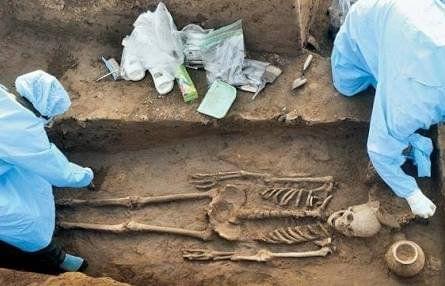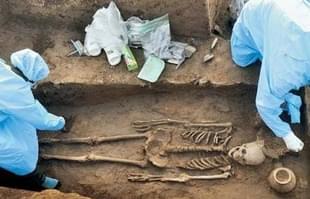News Brief
DNA Analysis Of A Skeleton Found At Sindhu-Saraswati Civilisation Site At Rakhigarhi Dents Aryan Invasion Theory
Swarajya Staff
Sep 06, 2019, 02:46 PM | Updated 02:46 PM IST
Save & read from anywhere!
Bookmark stories for easy access on any device or the Swarajya app.


The DNA analysis of a 4,500 year-old skeleton found at Rakhigarhi in Haryana bear no traces of the ‘Aryan gene’ or the R1a1 gene (Central Asian ‘steppe’ genes), reports The Print.
At the time, Rakhigarhi was part of the ‘mature Harappan civilisation’ or the Sindhu-Saraswati/ Indus Valley Civilisation (IVC).
“The population has no detectable ancestry from Steppe pastoralists or from Anatolian and Iranian farmers, suggesting farming in South Asia arose from local foragers rather than from large-scale migration from the West,” the study titled ‘An ancient Harappan genome lacks ancestry from Steppe pastoralists or Iranian farmers’ noted.
The study was authored by a team of Indian archaeologists and DNA experts from Harvard Medical School was published on Thursday in the scientific journal ‘Cell’.
“The paper indicates that there was no Aryan invasion and no Aryan migration and that all the developments right from the hunting-gathering stage to modern times in South Asia were done by indigenous people,” Professor Vasant Shinde, lead author of the paper was quoted as saying by the Economic Times.
The R1a1 gene is found in abundance in Indians today.
The paper claims Iranian genetic traits in the Indus Valley period and in present day South Asians come from ancient Iranian and South East Asian hunter-gatherers, much before the advent of large-scale farming. The study also suggests that farming in the subcontinent was developed indigenously “ without large-scale movement of people into these regions.”
Shinde concluded that their research “demonstrates the existence of an ancestry gradient that was widespread in farmers to the northwest of peninsular India at the height of the IVC, that had little if any genetic contribution from Steppe pastoralists or western Iranian farmers or herders, and that had a primary impact on the ancestry of later South Asians.”
Previously, Shinde had said,“Plenty of people believe the Aryans came from Central Asia. But we have no evidence of that. If they had migrated to India en masse, they would have imported their culture and traditions with them to our country — which is not the case at all.”
“We have evidence of contact with Iran and West Asia right from the beginning, for trading purposes. But it never amplified because of any migration during or after the Harappan civilisation,” he added.
The study also noted that a single sample or “even the gradient of 12 likely IVC samples” identified by the team could not “fully characterise a cosmopolitan ancient civilisation” while saying that the study was sufficient to demonstrate that the ancestry profile found by the study was a common feature of the IVC.
Shinde had also said that there was evidence to suggest the Harappan civilisation coincided with the writing of Hindu texts.
In 2018, some media outlets had used his research to argue that the latest genetic evidence supported the Aryan Invasion theory. Subsequently, Shinde had to come forward to deny such “fallacious” claims.
Aryan Invasion theory is dubbed as a colonial construct that argued that the fairer population of India had the same ancestors as the Europeans and responsible for the achievements of Indian civilisation. The theory with racist undertones blamed the downfall of “Indians” due to inter-mixing with the native black population.
Several other challenges have been raised against the theory. A major question is about the knowledge and reverence of river Saraswati river among ‘Aryans’ that used to flow from the heartland of the civilisation and disappeared much before the supposed Aryan invasion.





